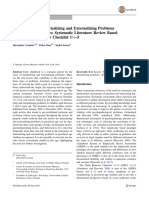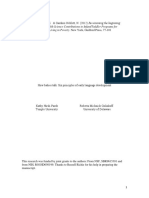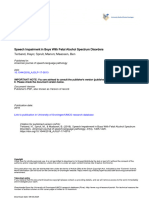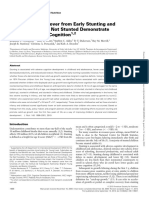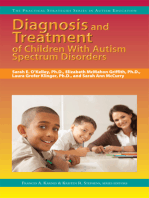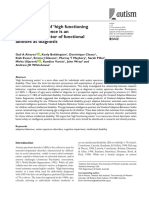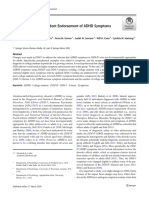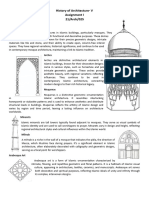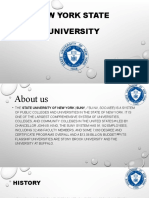Bhunyabhadh 2006
Bhunyabhadh 2006
Uploaded by
Raul Morales VillegasCopyright:
Available Formats
Bhunyabhadh 2006
Bhunyabhadh 2006
Uploaded by
Raul Morales VillegasOriginal Title
Copyright
Available Formats
Share this document
Did you find this document useful?
Is this content inappropriate?
Copyright:
Available Formats
Bhunyabhadh 2006
Bhunyabhadh 2006
Uploaded by
Raul Morales VillegasCopyright:
Available Formats
Special Article
Risk Factors Associated with Language Development
Problems in Childhood - A Literature Review
Bhunyabhadh Chaimay MPH*,
Bandit Thinkhamrop PhD*, Jadsada Thinkhamrop MD**
* Department of Biostatistics and Demography, Faculty of Public Health, Khon Kaen University, Khon Kaen
** Department of Obstetrics & gynecology, Faculty of Medicine, Khon Kaen University, Khon Kaen
Background: Children with language problems are found to have a higher risk for future academic difficulties
and learning disabilities. Conclusions from related literature were in many ways inconsistent.
Objective: To identify systematically, the existing literature, and factors that influence language development
in children.
Material and Method: Databases of scientific literature were screened through the internet for publications
that involved factors effecting language development in childhood. Hard copies of related scientific journals
were also sought for relevant topics by the authors, making use of reference lists of publications, and citation
search. Studies were included if they were published since 1984 and investigated factors that affect language
development in children. They were excluded if they were not original research articles.
Results: Fifteen studies were included for this review - a case-control study, a cross-sectional study, and
thirteen longitudinal studies. Most studies demonstrated that the following factors affect language develop-
ment - antenatal care, Apgar scores, birth weight, premature delivery, birth order, parental education,
environmental factors, gender of the children, and family history with specific language impairment.
Conclusion: Perinatal/postnatal and environmental factors influence language development. Such factors
should be taken into account as confounding factors in further language development studies.
Keywords: Language development, Child language development, Antenatal care, Apgar score, Birth weight,
Premature, Birth order, Parental education, Environmental factors, Gender and family history, Perinatal,
Postnatal, Social and Literature review
J Med Assoc Thai 2006; 89 (7): 1080-86
Full text. e-Journal: http://www.medassocthai.org/journal
Language development among children is a or behavioral problems(7-10). However, conclusions from
complex process and very important for communica- this literature were in many ways inconsistent. This
tion(1). Language impairments are common and well - paper reviews these studies in a systematic approach.
recognised as important neurodevelopmental childhood
disorders(2) defined as Specific Language Impairment Material and Method
(SLI). Children with sensory, neuromotor and cognitive Inclusion and exclusion criteria
deficits present an impairment of language development. Studies were included if they were published
The prevalence of SLI among preschool children has since 1984 and investigated factors that affect language
been estimated to be about 2% to 8%(3-5). Children with development in children. The studies were excluded if
language problems have been found to have a higher they were not original research articles, such as meta-
risk for future academic difficulties and learning dis- analysis or other types of review.
abilities(6), as well as for psychiatric, neurological, and/
Correspondence to : Chaimay B, Department of Biostatistics
Searching method
and Demography, Faculty of Public Health, Khon Kaen The authors searched relevant research
University, Khon Kaen 40002, Thailand. articles in PubMed database (www.ncb.nlm.nih.gov), a
1080 J Med Assoc Thai Vol. 89 No. 7 2006
reference database provided by the National Library Antenatal care (ANC)
of Medicine, USA. For searching titles, abstracts and As shown in Fig. 1, only one study investi-
keywords of papers the following terms had been used: gated the association between antenatal care and
“factors”, “language”, “development” and “children”. language development outcomes such SLI. From the
Initially the terms and combination of keywords or cross-sectional study by Stanton-Chapman et al(18) in
phrases have been applied such as “language develop- children age 6-7 years, there was a weak risk of SLI.
ment” and “child development”, and “factors and The children born to mothers enrolled for ANC at the
language development”. Additional search sessions 2nd, 3rd trimester showed a smaller risk compared to
used the keywords mentioned above in combination children born to mothers enrolled for ANC at the 1st
with the terms “factors”, “language”, “development” trimester.
and “children”. The MESH terms were used on these
for searching as well. Apgar scores
Another source of the articles was hard Apgar score is associated with child’s brain
copies of the leading journals of a given field and functional and neurological development. It is an indi-
identified relevant publications, especially those who cator of increased risk for specific language develop-
cross about narrow boundaries of a given topic of ment in school children. The study of Staton-Chapman
interest. The authors also followed references listed in et al(18) demonstrated that children who had Apgar
the relevant articles found by the searching methods scores of 0-3 at five minutes are more than two times
mentioned above. The authors did these until there likely to have SLI than those who had Apgar scores of
were no more articles left unidentified. seven or higher (Fig. 1).
Critical appraisal method Birth weight and premature birth
The authors focused their approach on the Four studies reported the association between
magnitude of effects for each factor using statistics birth weight and language outcome as shown in Fig. 1
that were presented in the papers. Mean differences and 2. The studies by Stanton-Chapman et al(18), Aram
were used if the outcome was measured on a continuous et al(11), and Weicdrich et al(21) clearly showed that birth
scale such as a score obtained by language develop- weight was a risk of unsatisfied language development
ment tools. In cases where the outcome was dichoto- outcome while the study by Rice et al(14) showed that
mous, Relative Risk (RR) or Odds Ratios (OR) were such evidence was not conclusive. Luoma et al(20) also
used as available. If such figures were not available in investigated language comprehension and production
the papers, existing numbers that allowed calculating in prematurely born children. This study found that
these were used STATA. The 95% confidence inter- there were lower scores in both language comprehen-
vals were calculated for each of the effects. To facili- sion and production.
tate interpretation, findings were presented as forest
plot. However, no attempt was made to combine such Breast feeding
results as this was not the aim of the presented paper. In Fig. 1, Tomblin et al(15) shows the signifi-
cant protective effect of breast feeding on SLI. That is,
Results breastfeeding can reduce the risk of SLI in about 50%
Twenty-five publications related were found and 60% in children that have been breast fed and had
but ten of these were excluded from the present review. breast feeding for more than nine months respectively.
The excluded studies were on unrelated language de- The risk effects were also reported to be about 1.5 times
velopment (four on mental and psychological develop- as likely for a child that had been breast fed for less
ment, one on adult language), not original research than three months, but were not significant. In addi-
articles (2), and inaccessible original papers (3). tion, a study by Vestergaard et al(24) found that the
Fifteen publications were included and longer the duration of Exclusive Breast Feeding (EBF),
were on case-control studies(11-15) (5), cross-sectional the better the polysyllable babblers.
studies(16-18) (3), cohort studies(1,19,20) (3), and longitu-
dinal studies(21-24) (4). Summary of the findings are Gender
shown in Fig. 1 and 2. The summary is presented in SLI is four times more prevalent in males than
forest plots. The studies were grouped according to females (4:1)(16). Mothers with SLI had seven times as
factors and described in detail. many boys and four times as many girls with SLI. A
J Med Assoc Thai Vol. 89 No. 7 2006 1081
Fig. 1 Summary the association of potential factors influencing language development in childhood. The magnitudes of
effects are presented as Odds Ratios (OR) and Relative Risks (RR) and 95% confidence intervals
1082 J Med Assoc Thai Vol. 89 No. 7 2006
Fig. 2 Summary the association of potential factors influencing language development in childhood. The magnitudes of
effects are presented as mean differences and 95% confidence intervals
J Med Assoc Thai Vol. 89 No. 7 2006 1083
recent study supported that children with a family his- original studies using a critical appraisal approach.
tory of SLI tend to be at greater risk for SLI than those This present review was scientifically concluded from
in families without SLI. This is true for both males and those studies to answer the purpose mentioned above.
females. In general, boys are at greater risk than girls(19) This implies that a number of potential risk factors
as shown in Fig. 1. influence language development in children, giving
details of those factors.
Birth order The literature suggests that factors that
Two studies demonstrate that the birth order significantly increase the risk of language impairment
effects children’s language development as shown in include antenatal care, Apgar scores, birth weight,
Figure 1. From the Horwitz et al study(17), the first born premature delivery, birth order, parental education,
children are two times more likely to gain benefits for environmental factors, gender of the children, number
language developmental skills than the later/single of siblings and family history with specific language
born child(17). Moreover, the results showed that later impairment. However, the roles of some factors are not
born children are 1.5 times more likely to have SLI than conclusive and need further investigation. These
children of first born order(18). include environmental factors such maternal age,
poverty, type of family. This review shows the clear
Parental education benefit of breast feeding on language development.
Three studies investigated parental education That is, the longer the duration of breast feeding, the
and children’s language development as shown in lower the risk of language impairment. While the studies
Fig. 1 and 2. Dollaghan et al(22) demonstrated that the have recently been completed, further research is
mean language score of mothers who completed less needed to determine the exact role of breast milk.
than high school was significantly lower than children
born to mothers who graduated from high school or References
higher. Tomblin et al(15) showed that parental educa- 1. Tallal P, Ross R, Curtiss S. Familial aggregation in
tion was associated with their children’s language specific language impairment. J Speech Hear
development. Children born to parents with low edu- Disord 1989; 54: 167-73.
cational level are more than two to three times likely to 2. Busari JO, Weggelaar NM. How to investigate and
have language impairment than those who were from manage the child who is slow to speak. BMJ 2004;
parents with a higher degree(15,18). 328: 272-6.
3. Law J, Boyle J, Harris F, Harkness A, Nye C. The
Environmental factors feasibility of universal screening for primary speech
Several environmental factors are associated and language delay: findings from a systematic
with a child’s language abilities such as children born review of the literature. Dev Med Child Neurol
from unmarried mothers are 1.5 times more likely to 2000; 42: 190-200.
have SLI than children born from married mothers. 4. Law J, Boyle J, Harris F, Harkness A, Nye C. Screen-
Factors such as maternal age, number of siblings, ing for primary speech and language delay: a
bilingual home and poverty are more likely to be risk systematic review of the literature. Int J Lang
factors of children with SLI(17). Children, who have Commun Disord 1998; 33(Suppl): 21-3.
bilingual homes, particularly, are about three times 5. Law J, Boyle J, Harris F, Harkness A, Nye C. Screen-
more likely to have increased expressive language ing for speech and language delay: a systematic
delay in preschool as shown in Fig. 1. review of the literature. Health Technol Assess
1998; 2: 1-184.
Family history with language developmental delays 6. Lewis BA, Freebairn LA, Taylor HG. Academic
There are several studies that have reported outcomes in children with histories of speech
the association between family history and language sound disorders. J Commun Disord 2000; 33: 11-30.
development delay as shown in Fig. 1 and 2. Children 7. Redmond SM, Rice ML. The socioemotional
born to families with a history of SLI are at risk of behaviors of children with SLI: social adaptation
language impairment. or social deviance? J Speech Lang Hear Res 1998;
41: 688-700.
Conclusion 8. Sasaki T, Okazaki Y, Akaho R, Masui K, Harada S,
The authors systematically summarized 15 Lee I, et al. Type of feeding during infancy and
1084 J Med Assoc Thai Vol. 89 No. 7 2006
later development of schizophrenia. Schizophr Heenan JM, Mendoza J, Carter AS. Language
Res 2000; 42: 79-82. delay in a community cohort of young children.
9. Kim H. What is the prevalence of social skill, J Am Acad Child Adolesc Psychiatry 2003; 42:
speech and language deficits in adolescents with 932-40.
significant psychiatric mental health problems? 18. Stanton-Chapman TL, Chapman DA, Bainbridge
[Web Page]. 2002; Available at http://www.med. NL, Scott KG. Identification of early risk factors for
monash.edu.au/healthservices/cce/evidence/ pdf/ language impairment. Res Dev Disabil 2002; 23:
b/377.PDF. (Accessed 8 March 2005). 390-405.
10. Fergusson DM, Woodward LJ. Breast feeding and 19. Choudhury N, Benasich AA. A family aggregation
later psychosocial adjustment. Paediatr Perinat study: the influence of family history and other
Epidemiol 1999; 13: 144-57. risk factors on language development. J Speech
11. Aram DM, Hack M, Hawkins S, Weissman BM, Lang Hear Res 2003; 46: 261-72.
Borawski-Clark E. Very-low-birthweight children 20. Luoma L, Herrgard E, Martikainen A, Ahonen T.
and speech and language development. J Speech Speech and language development of children
Hear Res 1991; 34: 1169-79. born at < or = 32 weeks’ gestation: a 5-year pro-
12. Tallal P, Hirsch LS, Realpe-Bonilla T, Miller S, spective follow-up study. Dev Med Child Neurol
Brzustowicz LM, Bartlett C, et al. Familial aggrega- 1998; 40: 380-7.
tion in specific language impairment. J Speech 21. Weindrich D, Jennen-Steinmetz C, Laucht M, Esser
Lang Hear Res 2001; 44: 1172-82. G, Schmidt MH. At risk for language disorders?
13. Tomblin JB. Familial concentration of developmen- Correlates and course of language disorders in
tal language impairment. J Speech Hear Disord preschool children born at risk. Acta Paediatr 1998;
1989; 54: 287-95. 87: 1288-94.
14. Rice ML, Haney KR, Wexler K. Family histories of 22. Dollaghan CA, Campbell TF, Paradise JL, Feldman
children with SLI who show extended optional in- HM, Janosky JE, Pitcairn DN, et al. Maternal edu-
finitives. J Speech Lang Hear Res 1998; 41: 419-32. cation and measures of early speech and language.
15. Tomblin JB, Smith E, Zhang X. Epidemiology of J Speech Lang Hear Res 1999; 42: 1432-43.
specific language impairment: prenatal and peri- 23. Spitz RV, Tallal P, Flax J, Benasich AA. Look who’s
natal risk factors. J Commun Disord 1997; 30: talking: a prospective study of familial transmis-
325-43. sion of language impairments. J Speech Lang Hear
16. Robinson RJ. Causes and associations of severe Res 1997; 40: 990-1001.
and persistent specific speech and language 24. Vestergaard M, Obel C, Henriksen TB, Sorensen
disorders in children. Dev Med Child Neurol 1991; HT, Skajaa E, Ostergaard J. Duration of breast-
33: 943-62. feeding and developmental milestones during the
17. Horwitz SM, Irwin JR, Briggs-Gowan MJ, Bosson latter half of infancy. Acta Paediatr 1999; 88: 1327-32.
J Med Assoc Thai Vol. 89 No. 7 2006 1085
ปัจจัยทีม่ คี วามสัมพันธ์ตอ่ ความผิดปกติของพัฒนาการทางภาษาในเด็ก - การทบทวนวรรณกรรม
ปุญญพัฒน์ ไชยเมล์, บัณฑิต ถิน่ คำรพ, เจศฎา ถิน่ คำรพ
ที่มา: เด็กที่มีความผิดปกติทางด้านภาษาพบว่ามีความเสี่ยงและส่งผลต่อความผิดปกติทางด้านการเรียน และ
การเรียนรู้ในวัยที่สูงขึ้น จากบทสรุปวรรณกรรมที่เกี่ยวข้องให้ผลที่ไม่สอดคล้องกันในหลายประเด็น
วัตถุประสงค์: เพื่อที่จะศึกษาปัจจัยที่มีผลต่อการพัฒนาการทางด้านภาษาในเด็กจากการทบทวนวรรณกรรม
ที่เกี่ยวข้องอย่างเป็นระบบ
วัสดุและวิธีการ: การศึกษาครั้งนี้เป็นการทบทวนวรรณกรรมที่เกี่ยวข้องกับปัจจัยที่มีผลต่อพัฒนาการทางด้าน
ภาษาในเด็ก โดยทำการสืบค้นข้อมูลจากฐานข้อมูลทางอินเตอร์เน็ต วารสารวิชาการที่เกี่ยวข้อง การสืบค้นจาก
เอกสารอ้างอิงตามงานวิจัยที่ได้รับการตีพิมพ์ และฐานข้อมูลในเอกสารอ้างอิง โดยรวบรวมงานวิจัยที่ศึกษาถึง
ปัจจัยที่มีผลต่อพัฒนาการทางด้านภาษาในเด็กที่ได้รับการตีพิมพ์ตั้งแต่ปี พ.ศ. 2527 งานวิจัยถูกทำการคัดออก
ในกรณีที่ไม่ได้เป็นงานวิจัยต้นฉบับ
ผลการศึกษา: จากการทบทวนวรรณกรรมพบว่ามีงานวิจัยที่เกี่ยวข้องจำนวน 15 เรื่อง เป็นการศึกษาแบบ case -
control study จำนวน 1 เรือ่ ง, การศึกษาแบบ cross-sectional study จำนวน 1 เรือ่ ง และการศึกษาแบบ longitudi-
nal study จำนวน 13 เรือ่ ง ผลการศึกษาส่วนใหญ่แสดงให้เห็นว่ามีปจั จัยต่าง ๆ ทีม่ ผี ลต่อพัฒนาการทางภาษา ได้แก่
การฝากครรภ์, Apgar score, น้ำหนักทารกแรกคลอด, การคลอดก่อนกำหนด, ลำดับที่ของบุตร, การศึกษาของ
บิดามารดา, ปัจจัยทางสิ่งแวดล้อม, เพศ และประวัติครอบครัวที่มีผิดปกติทางด้านภาษา
สรุป: ปัจจัยก่อนและหลังตั้งครรภ์ และปัจจัยทางสิ่งแวดล้อมมีอิทธิพลต่อพัฒนาการทางภาษาในเด็ก ดังนั้น
ปัจจัยดังกล่าวควรได้รับการควบคุมในการศึกษาในรูปแบบของปัจจัยกวน (confounding factors) ในการศึกษา
ทางด้านพัฒนาการทางภาษาต่อไป
1086 J Med Assoc Thai Vol. 89 No. 7 2006
You might also like
- High Yield Surgery Notes PDFDocument39 pagesHigh Yield Surgery Notes PDFrom9267% (3)
- Cost Acctg - Joint Cost. Quiz With AnswersDocument17 pagesCost Acctg - Joint Cost. Quiz With AnswersAlex Comeling100% (2)
- Early Language Processing EfficiencyDocument18 pagesEarly Language Processing Efficiencydesimaulia upgrisNo ratings yet
- Pediatrics 2007 Reilly E1441 9Document11 pagesPediatrics 2007 Reilly E1441 9Putu Agus GrantikaNo ratings yet
- Child Abuse & NeglectDocument20 pagesChild Abuse & Neglectrosan quimcoNo ratings yet
- Meta-Analysis The Effect of Breast Milk On Child LanguageDocument11 pagesMeta-Analysis The Effect of Breast Milk On Child LanguageAriqah GinaNo ratings yet
- Marchman, Early Lan. Processing Efficiency Predicts Later Receptive Vocab. Outcomes in Preterm Children-2Document20 pagesMarchman, Early Lan. Processing Efficiency Predicts Later Receptive Vocab. Outcomes in Preterm Children-2zdmzyxdkv5No ratings yet
- Infant-Mother Acoustic-Prosodic Alignment and Developmental RiskDocument13 pagesInfant-Mother Acoustic-Prosodic Alignment and Developmental RiskGintarė AmalevičiūtėNo ratings yet
- An Investigation of Health Anxiety in FamiliesDocument12 pagesAn Investigation of Health Anxiety in FamiliesAndreea NicolaeNo ratings yet
- Aud 0000000000000212Document10 pagesAud 0000000000000212axel pqNo ratings yet
- Risk Factors For Speech Delay of UnknownDocument12 pagesRisk Factors For Speech Delay of UnknownMaria de fatima MFconfecçõesNo ratings yet
- Nivens2023 - ACE + Developmenta DelayDocument6 pagesNivens2023 - ACE + Developmenta DelayKaren CárcamoNo ratings yet
- Risk Factors For Internalizing and Externalizing Problems in The Preschool Years Systematic Literature Review Based On The Child Behavior CheDocument13 pagesRisk Factors For Internalizing and Externalizing Problems in The Preschool Years Systematic Literature Review Based On The Child Behavior CheAna FerreiraNo ratings yet
- An epidemiological study on Finnish school-aged children with learning difficulties and behavioural problemsDocument14 pagesAn epidemiological study on Finnish school-aged children with learning difficulties and behavioural problemsslfynadullahNo ratings yet
- Language Disparities Related To Maternal Education Emerge by Two Years in A Low-Income SampleDocument10 pagesLanguage Disparities Related To Maternal Education Emerge by Two Years in A Low-Income SampleGintarė AmalevičiūtėNo ratings yet
- Retrieve Study PeabodyDocument11 pagesRetrieve Study PeabodyDebbie BenolielNo ratings yet
- Influence of Parenting Styles On Development ofDocument6 pagesInfluence of Parenting Styles On Development ofMeta Dwi FitriyawatiNo ratings yet
- Hubungan Menyusui Terhadap Perkembangan Motorik Dan Kemampuan BahasaDocument10 pagesHubungan Menyusui Terhadap Perkembangan Motorik Dan Kemampuan BahasaYossy RosmalasariNo ratings yet
- Zerbeto Association Between Gestational Age and Birth Weight on the Language Development of Brazilian Children a Systematic ReviewDocument7 pagesZerbeto Association Between Gestational Age and Birth Weight on the Language Development of Brazilian Children a Systematic ReviewamaldabesariNo ratings yet
- Literature ReviewDocument7 pagesLiterature ReviewsarasNo ratings yet
- Child Psychology Psychiatry - 2019 - Bal - Predictors of Longer Term Development of Expressive Language in Two IndependentDocument10 pagesChild Psychology Psychiatry - 2019 - Bal - Predictors of Longer Term Development of Expressive Language in Two IndependentUroosa AliNo ratings yet
- Annotated Bibliography Enhanced Milieu Teaching and Autism Spectrum DisorderDocument3 pagesAnnotated Bibliography Enhanced Milieu Teaching and Autism Spectrum Disorderapi-438170152No ratings yet
- Wong Et Al. - Psychosocial Development of 5-Year-Old Children With Hearing LossDocument13 pagesWong Et Al. - Psychosocial Development of 5-Year-Old Children With Hearing LossPablo VasquezNo ratings yet
- A Study of Prevalence and Factors Associated With Language Delay Among 0-3 Year Oldchildren in A Tertiary Teaching HospitalDocument4 pagesA Study of Prevalence and Factors Associated With Language Delay Among 0-3 Year Oldchildren in A Tertiary Teaching HospitalGautam BehlNo ratings yet
- Thesis Writing (Incidence of Pregnancy Among Adolescence)Document12 pagesThesis Writing (Incidence of Pregnancy Among Adolescence)Angel AgriamNo ratings yet
- RUJUKAN LATAR BELAKANG SKALA Speech Language Delay Screening Children Final Evidence SummaryDocument17 pagesRUJUKAN LATAR BELAKANG SKALA Speech Language Delay Screening Children Final Evidence SummaryAuliyaa NasywaNo ratings yet
- CurtisDocument17 pagesCurtisMarko CrivaroNo ratings yet
- Annotated Bibliography Child DevelopmentDocument6 pagesAnnotated Bibliography Child DevelopmentAntony AjowiNo ratings yet
- Dental Caries Status in Autistic Children: A Meta Analysis: Yujian Zhang Ling Lin Jianbo Liu Ling Shi Jianping LuDocument9 pagesDental Caries Status in Autistic Children: A Meta Analysis: Yujian Zhang Ling Lin Jianbo Liu Ling Shi Jianping Luzsazsa nissaNo ratings yet
- JAMA 2002 Bhutta 728 37Document10 pagesJAMA 2002 Bhutta 728 37BelenNo ratings yet
- Attachment and Temperament Revisited Infant DistressDocument15 pagesAttachment and Temperament Revisited Infant DistressMariana GCNo ratings yet
- ARHQ JLD REV2 TextDocument35 pagesARHQ JLD REV2 TextAsnairah Cati-an RashidNo ratings yet
- The Prevalence of Ankyloglossia in Children Aged Menor A 1 YearDocument8 pagesThe Prevalence of Ankyloglossia in Children Aged Menor A 1 YearGlenda SkinnerNo ratings yet
- Int J Speech Lang Pathol 2018 20 5 569-80Document12 pagesInt J Speech Lang Pathol 2018 20 5 569-80Fernando SousaNo ratings yet
- 2020 - Mode of Delivery, Order of Birth, Parental Age Gap and Autism Spectrum Disorder Among Malaysian Children - A Case-Control StudyDocument5 pages2020 - Mode of Delivery, Order of Birth, Parental Age Gap and Autism Spectrum Disorder Among Malaysian Children - A Case-Control Studyhuynhparis48No ratings yet
- Factors Associated With Expressive and Receptive Language in French-Speaking Toddlers Clinically Diagnosed With Language DelayDocument14 pagesFactors Associated With Expressive and Receptive Language in French-Speaking Toddlers Clinically Diagnosed With Language DelayRaul Morales VillegasNo ratings yet
- Are Mental Health Problems and Depression Associated With Bruxism in ChildrenDocument12 pagesAre Mental Health Problems and Depression Associated With Bruxism in ChildrenAhmad Ulil AlbabNo ratings yet
- Awareness ScaleDocument12 pagesAwareness ScaleMTC MilaorNo ratings yet
- Maternal Stress A Study of MoDocument25 pagesMaternal Stress A Study of MoArleen FuentesNo ratings yet
- Influence of Child Rearing by Grandparent On The Development of Children Aged Six To Twelve YearsDocument5 pagesInfluence of Child Rearing by Grandparent On The Development of Children Aged Six To Twelve YearsDimaz LawLiedthNo ratings yet
- 10.1055@s 0039 1677758Document2 pages10.1055@s 0039 1677758Verónica Gómez LópezNo ratings yet
- 10.1111 j.1365-3016.2010.01161.xDocument9 pages10.1111 j.1365-3016.2010.01161.xzhuzaijing70No ratings yet
- Developmental Assessment in Children at Higher Likelihood For Developmental Delays - Comparison of Parent Report and Direct AssessmentDocument11 pagesDevelopmental Assessment in Children at Higher Likelihood For Developmental Delays - Comparison of Parent Report and Direct Assessmentbambinos.fisioterapiaNo ratings yet
- Oral HealthDocument50 pagesOral HealthJelena JacimovicNo ratings yet
- Research StudyDocument15 pagesResearch StudyYogitha JainNo ratings yet
- Graunded Theory CHDDocument13 pagesGraunded Theory CHDWiwit ClimberNo ratings yet
- Screening For Speech and Language Delay2Document2 pagesScreening For Speech and Language Delay2irfan3003No ratings yet
- Behavioural, Emotional and Social Development of Children Who StutterDocument10 pagesBehavioural, Emotional and Social Development of Children Who StutterMagaliNo ratings yet
- Dental Fear and Concomitant Factors in 3-6 Year-Old ChildrenDocument5 pagesDental Fear and Concomitant Factors in 3-6 Year-Old ChildrenDrSugandh MittalNo ratings yet
- Hirsh-Pasek and Golinkoff 2012Document49 pagesHirsh-Pasek and Golinkoff 2012Francisco Javier Echenique ArosNo ratings yet
- Terband Spruit Maassen Speech Impairment AJSLP2018Document22 pagesTerband Spruit Maassen Speech Impairment AJSLP2018nereaalbangilNo ratings yet
- Variability in Verbal and Nonverbal Communication in Infants at Risk For Autism Spectrum Disorder: Predictors and OutcomesDocument15 pagesVariability in Verbal and Nonverbal Communication in Infants at Risk For Autism Spectrum Disorder: Predictors and OutcomesAlexandra DragomirNo ratings yet
- Birth Cohort Young Maternal Age and Poor Child Development: Predictive Validity From ADocument11 pagesBirth Cohort Young Maternal Age and Poor Child Development: Predictive Validity From Ayoshanda17No ratings yet
- Fetal Alcohol Spectrum Disorder HandoutDocument2 pagesFetal Alcohol Spectrum Disorder Handoutapi-753995548No ratings yet
- Early Childhood Predictors of Anxiety in Early AdolescenceDocument13 pagesEarly Childhood Predictors of Anxiety in Early AdolescenceDessyadoeNo ratings yet
- Week 17 - Handout - DIRFloortime Evidence-Base Quick FactsDocument3 pagesWeek 17 - Handout - DIRFloortime Evidence-Base Quick FactsEllieNo ratings yet
- ContentServer Monica2Document23 pagesContentServer Monica2Luis.fernando. GarciaNo ratings yet
- Communicative Environmental Factors Including Maternal Depression and Media Usage Patterns On Early Language DevelopmentDocument10 pagesCommunicative Environmental Factors Including Maternal Depression and Media Usage Patterns On Early Language DevelopmentGintarė AmalevičiūtėNo ratings yet
- Parenting Behaviors Among Anxious and Non Anxious Mothers Relation With Concurrent and Long Term Child OutcomesDocument20 pagesParenting Behaviors Among Anxious and Non Anxious Mothers Relation With Concurrent and Long Term Child OutcomesJust a GirlNo ratings yet
- Children Who Recover From Early Stunting and Children Who Are Not Stunted Demonstrate Similar Levels of CognitionDocument6 pagesChildren Who Recover From Early Stunting and Children Who Are Not Stunted Demonstrate Similar Levels of Cognitiontami ariyasraNo ratings yet
- Autism RiskDocument14 pagesAutism RiskAlina Topor Psi-MedicalNo ratings yet
- Diagnosis and Treatment of Children With Autism Spectrum DisordersFrom EverandDiagnosis and Treatment of Children With Autism Spectrum DisordersRating: 5 out of 5 stars5/5 (1)
- The Influence of Professional Teachers On Padang Vocational School Students' Achievement - ScienceDirectDocument16 pagesThe Influence of Professional Teachers On Padang Vocational School Students' Achievement - ScienceDirectRaul Morales VillegasNo ratings yet
- Search Education Resources: Instructional Leadership and Teachers' Functional Competency Across The 21st Century LearningDocument2 pagesSearch Education Resources: Instructional Leadership and Teachers' Functional Competency Across The 21st Century LearningRaul Morales VillegasNo ratings yet
- Intelligence Quotient (Iq) and Sex: Predictors of Academic Performance, Emotional State, Social Adaptability and Work AttitudeDocument14 pagesIntelligence Quotient (Iq) and Sex: Predictors of Academic Performance, Emotional State, Social Adaptability and Work AttitudeRaul Morales VillegasNo ratings yet
- View of The Importance of Soft Skills Acquisition by Teachers in Higher Education InstitutionsDocument1 pageView of The Importance of Soft Skills Acquisition by Teachers in Higher Education InstitutionsRaul Morales VillegasNo ratings yet
- BMC Medical EducationDocument31 pagesBMC Medical EducationRaul Morales VillegasNo ratings yet
- Alvares 2019Document12 pagesAlvares 2019Raul Morales VillegasNo ratings yet
- Opel 2020Document9 pagesOpel 2020Raul Morales VillegasNo ratings yet
- Iq and AdaptativeDocument27 pagesIq and AdaptativeRaul Morales VillegasNo ratings yet
- Cognitive and Adaptative BehaviorDocument13 pagesCognitive and Adaptative BehaviorRaul Morales VillegasNo ratings yet
- Antoniou 2021Document15 pagesAntoniou 2021Raul Morales VillegasNo ratings yet
- Tdah 4Document9 pagesTdah 4Raul Morales VillegasNo ratings yet
- Tdah 3Document14 pagesTdah 3Raul Morales VillegasNo ratings yet
- Comparison of Neuropsychological Functioning Between Adults With Early-And Late-Onset DSM-5 ADHDDocument12 pagesComparison of Neuropsychological Functioning Between Adults With Early-And Late-Onset DSM-5 ADHDRaul Morales VillegasNo ratings yet
- Changes in College Student Endorsement of ADHD Symptoms Across DSM EditionDocument12 pagesChanges in College Student Endorsement of ADHD Symptoms Across DSM EditionRaul Morales VillegasNo ratings yet
- Pathogenic Yield of Genetic Testing in Autism Spectrum DisorderDocument11 pagesPathogenic Yield of Genetic Testing in Autism Spectrum DisorderRaul Morales VillegasNo ratings yet
- 10 1192@bjp 2020 152Document8 pages10 1192@bjp 2020 152Raul Morales VillegasNo ratings yet
- 3 - PPT - CCS Pension Rules, 2021Document20 pages3 - PPT - CCS Pension Rules, 2021Dileepoo7No ratings yet
- Bright Septic TankDocument1 pageBright Septic TankNiđe VezeNo ratings yet
- Christopher Martin - Spinoza's Argument For Substance Monism - Why There Is Only One Thing-Lexington Books (2023)Document135 pagesChristopher Martin - Spinoza's Argument For Substance Monism - Why There Is Only One Thing-Lexington Books (2023)Carlos PachecoNo ratings yet
- Exp 1 Mold: Microscopic Identification and Identification of Mold From FoodDocument8 pagesExp 1 Mold: Microscopic Identification and Identification of Mold From FoodNurizzatiaini75% (4)
- SawatdeeDocument3 pagesSawatdeeHarith Mage Main50% (2)
- Gpu-Str-P-01 Str-P-02 - North/South East/West Pipe Rack FoundationDocument1 pageGpu-Str-P-01 Str-P-02 - North/South East/West Pipe Rack FoundationJames PittsNo ratings yet
- 21 Arch 025 Hoa IDocument2 pages21 Arch 025 Hoa IMuhammed SinanNo ratings yet
- 1.0 Syllabus (Sample Only) Course Name Trigonometry Course Credit Course Description Contact Hours/week Prerequisite Course OutcomesDocument24 pages1.0 Syllabus (Sample Only) Course Name Trigonometry Course Credit Course Description Contact Hours/week Prerequisite Course OutcomesAngelica Banad SorianoNo ratings yet
- The Sword of Moses Harba De-Moshe A New PDFDocument41 pagesThe Sword of Moses Harba De-Moshe A New PDFgarytorres2167% (3)
- Module 1 Concept Paper OrientationDocument4 pagesModule 1 Concept Paper OrientationJaja TorobaNo ratings yet
- IA 111 Lecture 00 Year 2023-2024Document10 pagesIA 111 Lecture 00 Year 2023-2024anime admirersNo ratings yet
- GPS Velocities and The Construction of The Eastern Cordillera of The Eastern Cordillera of The Colombian AndesDocument10 pagesGPS Velocities and The Construction of The Eastern Cordillera of The Eastern Cordillera of The Colombian Andeslorenatb674No ratings yet
- How To Read Your Water BillDocument2 pagesHow To Read Your Water BillxmnmnsuNo ratings yet
- New York StateDocument8 pagesNew York StateOIS StudentNo ratings yet
- CURRICULUM VITAE SachinDocument3 pagesCURRICULUM VITAE SachinSAGAR SINGHNo ratings yet
- Cellular LTE-A Technologies For The Future Internet-of-Things: Physical Layer Features and ChallengesDocument28 pagesCellular LTE-A Technologies For The Future Internet-of-Things: Physical Layer Features and ChallengeshusseinelatarNo ratings yet
- A.K. Ramanujan's "Obituary"Document14 pagesA.K. Ramanujan's "Obituary"Ahmed Ali100% (1)
- Tugas Inggris Chapter 2Document5 pagesTugas Inggris Chapter 2Alam MahardikaNo ratings yet
- Bidge Deck AnalysisDocument37 pagesBidge Deck AnalysisGaurab100% (1)
- João Batista de Almeida - Logic Price 47pgsDocument47 pagesJoão Batista de Almeida - Logic Price 47pgskiranebooks21No ratings yet
- Latihan GerundDocument3 pagesLatihan GerundJenny ChristantiNo ratings yet
- MM-201 Lectures - Spring 2024Document40 pagesMM-201 Lectures - Spring 2024abdurrafayzeNo ratings yet
- Mrunal (Economic Survey Ch6) Balance of Payments, Forex Reserves, Currency Exchange, NEER, REER PrintDocument14 pagesMrunal (Economic Survey Ch6) Balance of Payments, Forex Reserves, Currency Exchange, NEER, REER PrintAnil CletusNo ratings yet
- New Product DevelopmentDocument3 pagesNew Product Developmentविशाल गुप्ताNo ratings yet
- 4MB1 01R MSC 20190307 PDFDocument15 pages4MB1 01R MSC 20190307 PDFAbdullah Al MamunNo ratings yet
- Teacher Leaderself Assessment NalianDocument4 pagesTeacher Leaderself Assessment Nalianapi-572204493No ratings yet
- Primal Glass: (Case Study) Aswin - 36005Document7 pagesPrimal Glass: (Case Study) Aswin - 36005harish ramalingamNo ratings yet
- Tax Audit Reporting (GBCA) - Sanjeev LalanDocument59 pagesTax Audit Reporting (GBCA) - Sanjeev LalanVenkateshNo ratings yet












